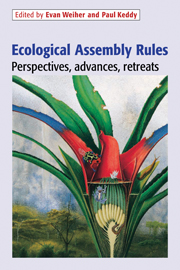Book contents
- Frontmatter
- Contents
- List of Contributors
- Introduction: The scope and goals of research on assembly rules
- Part I The search for meaningful patterns in species assemblages
- Part II Other perspectives on community assembly
- 8 On the nature of the assembly trajectory
- 9 Assembly rules as general constraints on community composition
- 10 A species-based, hierarchical model of island biogeography
- 11 Interaction of physical and biological processes in the assembly of stream fish communities
- 12 Functional implications of trait–environment linkages in plant communities
- 13 When does restoration succeed?
- 14 Epilogue: From global exploration to community assembly
- Index
11 - Interaction of physical and biological processes in the assembly of stream fish communities
Published online by Cambridge University Press: 04 September 2009
- Frontmatter
- Contents
- List of Contributors
- Introduction: The scope and goals of research on assembly rules
- Part I The search for meaningful patterns in species assemblages
- Part II Other perspectives on community assembly
- 8 On the nature of the assembly trajectory
- 9 Assembly rules as general constraints on community composition
- 10 A species-based, hierarchical model of island biogeography
- 11 Interaction of physical and biological processes in the assembly of stream fish communities
- 12 Functional implications of trait–environment linkages in plant communities
- 13 When does restoration succeed?
- 14 Epilogue: From global exploration to community assembly
- Index
Summary
Introduction
The concept of assembly rules originally was developed by Diamond (1975) to describe regular patterns of species occurrence on islands, and has since been generalized to include all processes influencing community development, the emphasis on colonization and extinction having lessened somewhat (Drake, 1990a; Nee, 1990). The contemporary meaning of community assembly also de-emphasizes the term ‘rule’ in favor of less-fixed combinations of interactions and outcomes that are known to occur within different communities (Post & Pimm, 1983; Wilbur & Alford, 1985; Gilpin et al., 1986; Robinson & Dickerson, 1987; Robinson & Edgemon, 1988; Barkai & McQuaid, 1988; Drake, 1988, 1990b, 1991; Drake et al., 1993; Case, 1991; Keddy, 1992; Weiher & Keddy, 1995a, b). Community assembly now encompasses the ecology and short-term, observable evolution of the community from initial colonization to species saturation, and logically includes a number of topics that are referred to by other names, such as trophic cascades (Carpenter & Kitchell, 1993), top-down vs. bottom-up regulation of trophic webs (Matson & Hunter, 1992), and the regulation of biodiversity (Rosenzweig, 1995). The scope of the processes involved and the applicability of assembly rules to all communities makes this one of the central problems in ecology.
Although the physical environment is important in a number of ways, there has been more focus upon biological interactions in assembly processes. The traditional view is that environmental gradients act principally to filter some species out of the pool of potential immigrants (Drake, 1990b).
- Type
- Chapter
- Information
- Ecological Assembly RulesPerspectives, Advances, Retreats, pp. 311 - 337Publisher: Cambridge University PressPrint publication year: 1999
- 7
- Cited by



